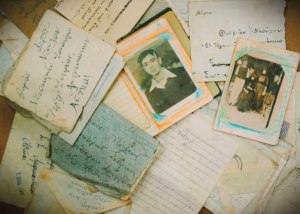People without hope, struck by tuberculosis and stacked in the wards of “Sotiria” Hospital, were found alone and unaided, and “departed” without ever being sought, not even after death. These were the tuberculosis patients who lived in the premises of the then sanatorium, from 1945 to 1975, and remained unnoticed until today. But now they gain a voice and become, as they say, “visible” thanks to the stunning documentary “Unclaimed” by Marianna Economou, which is expected to be screened at the upcoming Thessaloniki Documentary Festival, as part of the International Competition.
Stories of people whom even their relatives did not seek out are now coming to haunt the lives of the living and, overall, our own lives, as they did not even have a dignified death and were buried in mass graves, apparently on the hospital grounds. The renowned internationally acclaimed director and producer Marianna Economou, who represented Greece at the 92nd Oscars with her unforgettable film “When Wagner met the Tomatoes,” took on the task of bringing their moving stories to light, not only as a creator but also as an intermediary to finally give them a voice.

“It’s truly staggering to think that I came into contact with these people by chance and that all of this happened thanks to the factor of luck,” says Marianna Economou, speaking about the incredible story of finding the primary material that brought these stories to light.
“The material was revealed entirely by chance as it was hidden behind a wall of ‘Sotiria’ Hospital, which had to be torn down due to a leak. Behind it, some suitcases filled with items, correspondence, photographs, etc., were found. They even decided to throw them away, but again entirely by chance, the hospital’s tailors heard the noise from the conversations and the garbage trucks of the hospital, and they tried to stop them. As they realized that these belonged to patients who had died, they managed to call doctors who intervened and asked for the suitcases to be kept in storage. So purely by chance, these people did not end up in the trash, and again entirely by chance, a doctor mentioned this story to me at a meeting, catching my attention. When I saw the packages of correspondence and some small items up close, I was deeply moved, and I realized that I had to get involved, literally as if they were calling me.”
And so it happened, but the material was enormous—we’re talking about at least 300 patients—and the time they had at their disposal, both she and her collaborators, to select what to keep and decode it, was minimal. “We had only ten days, and we had to rush with the presence of a museum expert to select some of the total 300 packages, which we simply pulled; we didn’t have time to read them in detail. Along the way, we started decoding them carefully and collecting information.”
Nordic Monitor: Turkish intelligence-backed NGO organizing a new flotilla to Gaza by end of March
And this was another even more challenging task as they brought to light stunning stories, full of pain and suffering, with real protagonists, people whom no one knew for years whether they were alive or dead, whom some ignored and kept away even from their own children. “They were mostly people from different parts of Greece. So we see how they lived in times of terrible poverty and war, how the country was from the 1940s to the ’70s, and how difficult it was for these families to have contact from afar with their patients. In many letters, we see them begging for medicine, some injections, relatives expressing despair because they can’t even send them the basics—not just medicine but food or clothes. Many of them even addressed various organizations, wealthy philanthropists, even the Palace, begging for help. This was the helplessness but also the fear of contagion that gradually turned these people into objects of a kind of racism: in the film, we have a stunning story where a father tells his daughter not to come back and not to appear because they had to marry off her brother! However, without intending to interfere in these stories, to judge or to make a historical record, we simply wanted to let these voices be heard through the perspective of the patients and their relatives,” she concludes, explaining the rationale behind the approach to the material and the central goal of creating the film.
>Related articles

Apart from being an informal police reporter, as she ended up having to find the relatives of the “Unclaimed” people and reveal their story, she also took on the task of solving the mystery of their deaths: “It’s terrible to think that these people may have been buried in the hospital’s courtyards, without a cross, without anyone talking about it. It’s like a hidden secret that no one wants to mention”. Many, of course, report various stories about dogs digging and bringing to light various human bones, especially after rain, about people who know that there are dead bodies in the areas of “Sotiria”, but without further details.
After all, it’s a hospital with a long history, which began in 1903 when the foundations of the first sanatorium for the treatment of tuberculosis patients in Greece were laid on a 50-acre site provided by the Petráki Monastery. Gradually, the remaining buildings were constructed, and in the 1940s, the association of tuberculosis patients of the hospital was founded. “Sotiria” was Sophia Sliman’s vision to create a space of rest and therapy for those suffering from consumption, as there was a sense then that the mountain and the greenery surrounding the area helped the patients. Marianna Economou informs us that efforts are being made to create a museum on the hospital grounds that will unravel its history, which ultimately is intertwined with the life of the place.
Ask me anything
Explore related questions





